HTC One max Review - It's Huge
by Brian Klug on October 28, 2013 10:00 AM EST- Posted in
- Smartphones
- HTC
- Mobile
- One
- Snapdragon 600
- Android 4.3
- One max
Battery life remains a huge concern for savvy smartphone shoppers. Opportunistically charging a phone and worrying about making it through an entire day with just a single charge cycle is a common complaint as well. The HTC One max addresses some of the complaints myself and others had with charging on the HTC One which charged at only 1 amp, instead the One max charges at up to 1.5 amps. Although I wasn’t sampled it, the One max box will also include a 1.5 amp charger from HTC that’s slightly taller than the previous generation. This definitely helps offset the increase in charge time that would’ve resulted given the 43 percent larger 3300 mAh 3.8V (12.54 watt hour) battery.
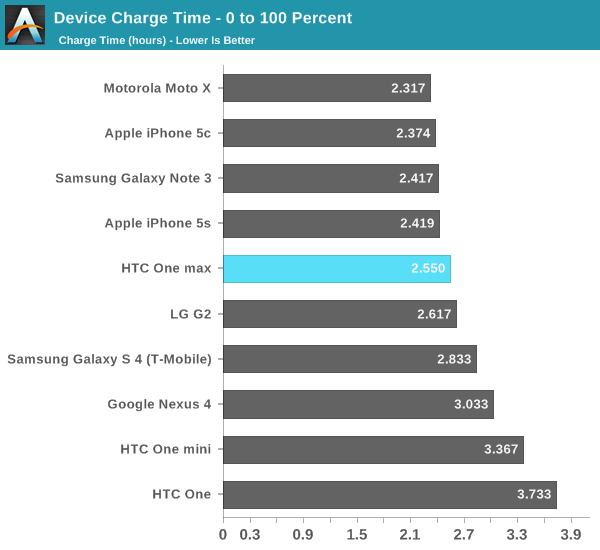
The HTC One charges a bit faster with the latest updates, however the linear region of the charge curve is entirely dominated by that 1 A charging maximum. With the 1.5 A charging in the One max we actually see considerably faster charge times in spite of the larger battery. HTC continues to use BC 1.2 to the best of my knowledge for signaling.
To assess battery life, I ran the One max through our battery life test suite. Our battery life test is unchanged, we calibrate the display to exactly 200 nits and run it through a controlled workload consisting of a dozen or so popular pages and articles with pauses in between continually, until the device dies. This is repeated on cellular and WiFi, in this case since we have an international model of the One max that lacks the LTE bands used in the USA, that’s 3G WCDMA on AT&T’s Band 2 network. The talk time call test is self explanatory and also unchanged.
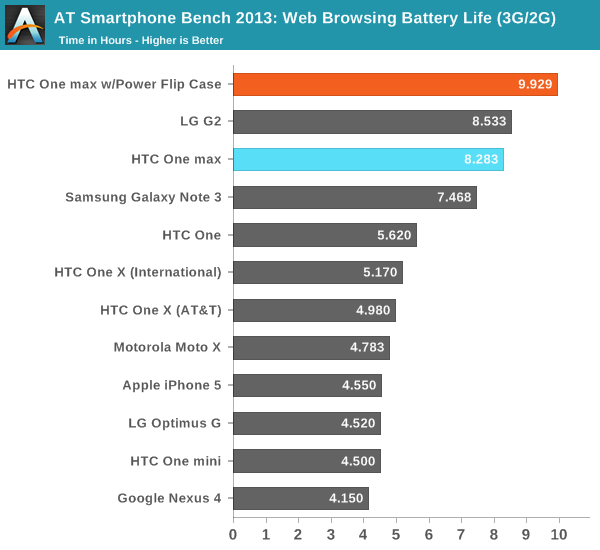
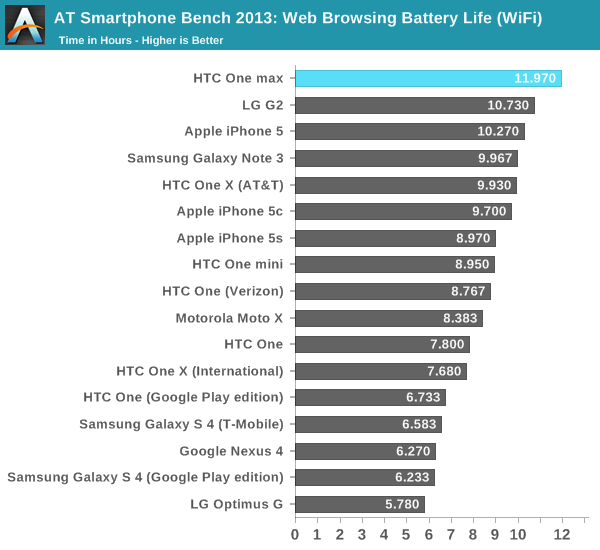
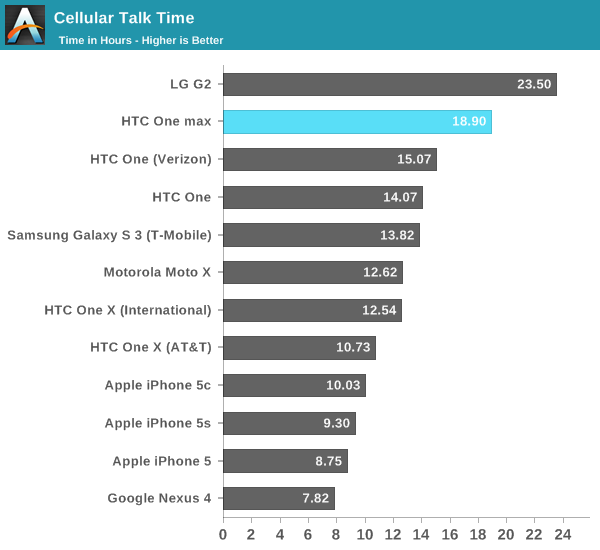
The results speak for themselves, the One max lasts quite a long time on battery, even with a large display. I expected the One max to lose to the Note 3 on the cellular test initially, but it posts an impressive result. I suspect display power might be the reason here between AMOLED and the more pragmatic LCD in the One max. I measured the One max with the flip case on as well, and it adds about 20 percent more battery time to the device. I'm curious to see how the USA-bound variants with LTE fare, but the One does impress with excellent battery life.


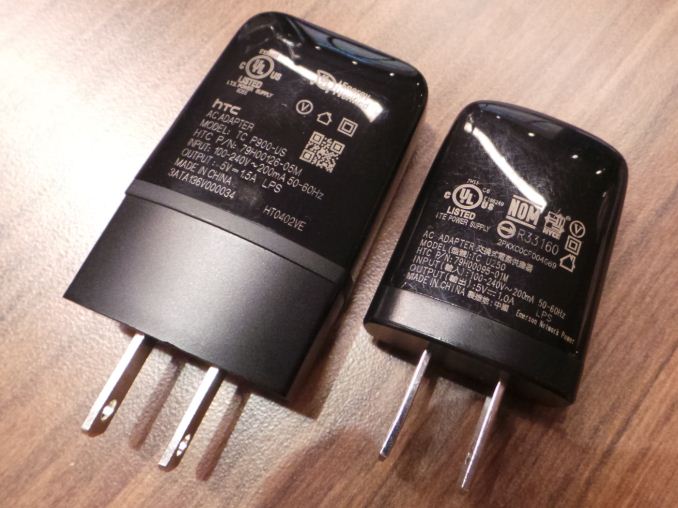








197 Comments
View All Comments
smartypnt4 - Monday, October 28, 2013 - link
One thing people always brag about on Android is consumer choice. If Samsung more fits your needs, more power to you. But I fail to see how removing one of the top tier Android phone manufacturers is a good thing. I don't want any one company to be massively ahead of the rest in market share, because I believe some competition is a good thing and prevents companies from resting on their previous success and putting out crap new products.Say what you will about mircoSD slots. Personally, I don't store much on my phone anyway, so it's not a big deal to me. But please don't espouse the absurd opinion that removing players from the Android space will in any way improve it.
smartypnt4 - Monday, October 28, 2013 - link
Shit. On my phone. Did not mean to reply to you, but rather the guy you commented on. My bad.JeffFlanagan - Monday, October 28, 2013 - link
>Shit. On my phone.OK, but you're going to need a new phone.
nerd1 - Monday, October 28, 2013 - link
HTC one is a nice device but it has too many deal breakers for me and more (no micro sd, sealed battery, almost non-repairable, terrible QC, low-resolution camera)They basically shot their own feet, trying the apple way, while being no apple.
smartypnt4 - Monday, October 28, 2013 - link
Clearly you missed my point. I'm not interested in arguing the merits of a removable battery or microSD card slot. All I'm saying is that dude needs to chill out. If the Android space is truly about choice, what do you care what HTC does as long as SOMEONE makes the phone you want. In this case, HTC's phones this year clearly don't meet your needs/requirements, and that's fine. Saying they shot themselves in the foot is a bit harsh, though. I know several people who bought HTC Ones over SGS4's simply because of how the thing felt when they held the device. Say what you will about specs, features, etc., but not everyone values the same things you do. Hard to accept, I know. But my good lord. Are you really so shortsighted as to believe that the general population gives a rat's ass about removable batteries, SD card slots, phone repairability (wtf?), anecdotal evidence of bad QC, and a camera that makes heavy tradeoffs (in this case, IQ for low-light performance)?Not everyone has exactly the same desires or needs as you. Which is the beauty of the Android space: people have the luxury of choice, which you only get with multiple manufacturers competing in the same space.
/endrant
nerd1 - Monday, October 28, 2013 - link
So the device w/o micro sd slot is effectively $100-200 more expensive than device with one.iPhone 5s 64GB: $399 w/contract, total storage 64GB
S4 16GB + 64GB sdxc : around $200 w/contract, total storage 80GB
I know companies prefer to removing the slot to sell the high capacity devices with greater margin (BOM difference of 16GB and 64GB devices is almost negligible) but why we consumers blindly follow what they are doing?
MKy - Monday, October 28, 2013 - link
I can understand Apple there. Adding an SD card slot would be adding a means for the user to completely ruin the experience. Internal flash of my Ipad 4 reads/writes about 160MB/s, don't know about the newer models. A cheap SD card reads about 4 MB/s, writes even worse. So imagine running apps off it or using it as data storage. Would be painful.Spunjji - Monday, October 28, 2013 - link
Simple solution: Refuse to support cheap-ass storage. Validate some cards and support those, refuse app installation to SD. My 64GB Micro SDXC benches faster than most phone NAND... it cost me £40.kyuu - Monday, October 28, 2013 - link
I haven't been able to find any actual data on the storage performance of the iPad 4 (or any iPad for that matter), but I find your 160MB/s number rather unlikely. The storage used in iPads is the same used in iPhones, to the best of my knowledge, which isn't very fast.MKy - Monday, October 28, 2013 - link
Actually it is that fast. You can find benchmarking tools in the app store and even measure it by hand - open a say 5 gig video in one app and then choose open in another, then count the seconds it takes to copy it over (the delay after issuing the command) and calculate. The flash in iphone 5 is about the same speed.